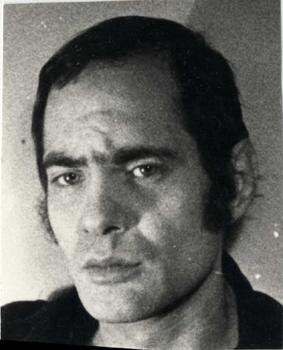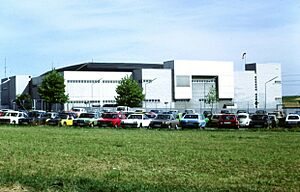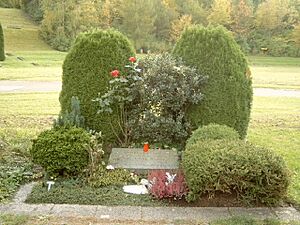Andreas Baader facts for kids
Quick facts for kids
Andreas Baader
|
|
|---|---|

Andreas Baader, when he was imprisoned in Stuttgart-Stammheim.
|
|
| Born |
Berndt Andreas Baader
6 May 1943 |
| Died | 18 October 1977 (aged 34) |
| Organization | Red Army Faction |
Berndt Andreas Baader (born May 6, 1943 – died October 18, 1977) was a leader of the Red Army Faction (RAF). This was a left-wing group in West Germany. It was also known as the Baader-Meinhof Group.
Contents
Early Life
Andreas Baader was born in Munich, Germany. This was on May 6, 1943. He was the only child of Dr. Berndt Phillipp Baader and Anneliese Hermine "Nina" (Kröcher). Andreas was raised by his mother, aunt, and grandmother. His father served in the army during World War II. He was captured in 1945 and never came home.
Baader left high school early. He did not go to university, unlike many other RAF members. At age twenty, Baader moved to West Berlin. He said he wanted to study art. He worked as a construction worker for a time. He also tried to be a journalist, but this was not successful.
Baader took part in some protests in 1962. These were called the Schwabing riots. His mother said he felt that "something was wrong" with the government after seeing how the police acted. A journalist named Butz Peters said these events were "a shocking experience" for the nineteen-year-old Baader.
Joining the Red Army Faction
In 1968, Baader and his girlfriend, Gudrun Ensslin, were found guilty. They had set fire to a department store in Frankfurt. They did this to protest what they called public "indifference to the genocide in Vietnam."
After being sentenced, Baader and Ensslin escaped in November 1969. Friends helped them leave West Germany. They traveled through France, Switzerland, and Italy. Then, they secretly returned to West Germany in early 1970.
Baader was later caught by police in Berlin. This happened on April 4, 1970, because he was speeding. He used a fake driver's license. It was in the name of an author, Peter Chotjewitz. But he was arrested when he could not answer questions about Chotjewitz's children.
Ensslin then planned an escape for Baader. A journalist, Ulrike Meinhof, and Baader's lawyers made up a fake "book deal." Meinhof would interview Baader for this book. A few weeks later, in May 1970, Baader was allowed to meet Meinhof. This meeting was at a library outside the prison. He was not handcuffed but had two armed guards. Meinhof was allowed to join them.
Two friends, Irene Goergens and Ingrid Schubert, came into the library. They carried suitcases. They opened a door to let in a masked person with a pistol. Then, they pulled pistols from their suitcases. They fired shots, hurting a 64-year-old librarian. Baader, the masked person, and the three women escaped through a window.
The group became known as the Baader-Meinhof Group. Baader and others went to a training camp in Jordan. They were later sent away because of "differences in attitudes." Back in West Germany, Baader was involved in robbing banks. He also bombed buildings between 1970 and 1972. Baader loved driving, even though he never got a driver's license. He often stole expensive sports cars for the group. He was arrested while driving an Iso Rivolta IR 300.
On June 1, 1972, Baader and other RAF members, Jan-Carl Raspe and Holger Meins, were caught. This happened after a long shootout in Frankfurt.
Imprisonment in Stammheim
From 1975 to 1977, a long and costly trial took place. It was held in a strong building at Stuttgart's Stammheim Prison. To prevent things from being smuggled in, prisoners were searched. They were given new clothes before and after meeting their lawyers.
In 1974, the prisoners went on a hunger strike. This led to the death of Holger Meins. The famous thinker Jean-Paul Sartre visited Baader in Stammheim. Sartre did not like Baader's behavior. However, he criticized the harsh prison conditions Baader faced.
Ulrike Meinhof was found dead in her cell on May 9, 1976. Members of the Red Army Faction said she was killed by German authorities. The next generation of the RAF carried out kidnappings and attacks. They did this to support their imprisoned friends.
The three remaining defendants were found guilty in April 1977. They were convicted of several murders and attempted murders. They were also found guilty of forming a terrorist group. They were sentenced to life in prison.
Militants tried to force the release of Baader and ten other RAF members. They kidnapped a businessman named Hanns Martin Schleyer in Cologne. This happened on September 5, 1977. This was part of a series of events known as the "German Autumn." This period began on July 30, 1977, with the murder of a banker, Jürgen Ponto.
On September 6, 1977, the government said the prisoners would not be released. On the same day, a "communication ban" was put on all RAF prisoners. This meant prisoners could not contact each other or the outside world. All visits, even from lawyers and family, were forbidden. Prisoners could not get mail, newspapers, or watch TV. The government said this was because the prisoners had helped plan Schleyer's kidnapping from their cells. They claimed a map used in the kidnapping was found. On October 18, 1977, the RAF killed Schleyer in France.
On October 13, 1977, four members of another group hijacked a plane. It was Lufthansa Flight 181. They demanded the release of the eleven RAF prisoners at Stammheim. The plane was flown to Mogadishu, Somalia. German special forces freed the passengers on October 18, 1977. Three of the hijackers died.
Death
According to official reports, Jan-Carl Raspe learned about the successful rescue of the plane. He heard this on a secret radio. He then talked to Baader, Ensslin, and Möller for hours. In the morning, they were found dead. Another RAF member, Irmgard Möller, was found hurt but survived.
Cultural Depictions
- The Murder of Andreas Baader is a 1978 painting by Odd Nerdrum. It shows Baader as if he was murdered.
- Stammheim – Die Baader-Meinhof-Gruppe vor Gericht (1986) is a film. It was directed by Reinhard Hauff. Ulrich Tukur played Andreas Baader. The film won an award at the 1986 Berlin Film Festival.
- Death Game (1997) is a TV movie. It was made by Heinrich Breloer. Sebastian Koch played Andreas Baader. It is about the kidnapping and killing of Hanns-Martin Schleyer.
- In 2002, director Christopher Roth released the film Baader. Frank Giering played the main role. It covers the time between 1967 and 1972.
- Baader was played by Moritz Bleibtreu in the film The Baader Meinhof Complex. This film was nominated for an Oscar in 2009.
See Also
 In Spanish: Andreas Baader para niños
In Spanish: Andreas Baader para niños
- Baader–Meinhof effect, a thinking pattern named after Baader



